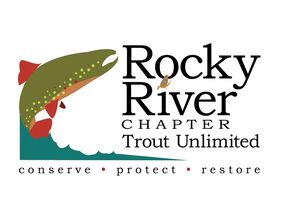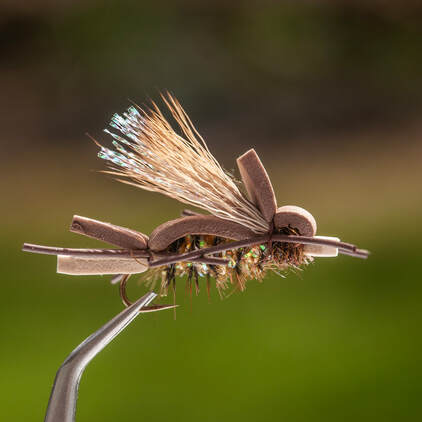Fly of the Month 06.23 Amy’s Ant
Created, invented and originated by the fly fishing industry legend Jack Dennis on the Snake River system in Wyoming, Amy’s Ant won the Yellowstone Angler One Fly contest in 1999. Jack named this fly after his daughter Amy. A Jack Dennis classic, first designed for the Jackson Hole One Fly. It is anything but an actual ant imitation but does an excellent job of suggesting a cicada, hopper or stonefly while being durable, tough and reliably buoyant. Like most attractors, numerous effective color variations have evolved from the original, making it a very popular flies for trout.
Amy’s Ant
Amy’s Ant is a foam bodied fly pattern that you must have in your dry fly box. Fish the larger version of this fly to match golden and nocturnal stones or as a searching pattern during terrestrial season. It is not a “guide fly” as it requires a solid set of tying skills and particular care with proportions and thread control.
It is beautifully tied by combining 2 mm foam, Krystal Chenille, trimmed down hackle, lively rubber legs and elk hair topping a flashy underwing. Amy’s Ant is generic enough to roughly imitate a variety of food sources in the trout world. The elk-hair wing sits at an angle that ensures the fly lands upright every time and remains highly visible even in choppy water. The shape of the foam head tends to spread out the hair a bit to simulate the fluttering wings of an insect in trouble. It has a two-toned foam body, two sets over rubber legs, and an elk hair wing wing with plenty of rainbow Krystal Flash underneath.
No one knows why, but the Amy’s Ant fly simply makes fish lose their inhibitions! The trimmed hackle palmered through the shiny Krystal Chenille body sets this fly low on the surface, while the double-layer foam overbody allows for a built-in life preserver to keep it on top even after repeated assaults. A splash of multicolored flash as an underwing adds fish attracting-sparkle and movement.
“Jack Dennis has a fairly complicated storyline regarding this fly, and its inception at the hands of his wife and then soon-to-be Vice President Dick Cheney. It seems the two were paired up as a team in the Jackson Hole One Fly event, and they conspired to get Jack to design a fly for them. Jack mashed up his original Amy’s Stone pattern with a Chernobyl Ant and a couple other Western patterns he had taken a liking to, and the result is what you see here.
The Dennis/Cheney team came in fourth using this fly, but the first- as well as last-place teams used it as well! Cheney was later interviewed during a fishing segment for an outdoor television show. When asked what his favorite fly was, he named Amy’s Ant.
Dennis immediately imagined the money rolling in from such a high-profile endorsement, and was excited to see the broadcast, but that just happened to be the week of 9/11, and the episode was never shown. Despite all that, Amy’s Ant became hugely popular and is Dennis’s most popular and best-selling pattern. That’s endorsement enough.” - Charlie Craven
When and How To Fish Amy’s Ant
Amy’s Ant is typically fished on a stout 0X to 3X leader, most often with a beadhead dropper riding along underneath. When fished close to the bank as a single fly, Amy’s Ant fools some of the pickiest fish into a strike. It’s an adaptable summertime dry fly that imitates a variety of insects and acts as a simple attractor when desired. It is both a great trout fly and a great bass fly.
You can fish the Amy’s Ant like any large terrestrial, except use it year round, with the following techniques:
Float it under and near overhanging vegetation on stream, in ponds, lakes and reservoirs
Float it right past the eddy line below riffles and constrictions in the river
Skate it over the surface at night to attract larger fish, like you would a mouse pattern
Use a dropper fly with it, such as an emerger, soft hackle, or nymph
When using Amy’s Ant, be ready for quick, aggressive and very hard strikes!
Fly of the Month 06.23
Fly Name: Amy's Ant
Hook: Tiemco 5262 or 5263
Size: 6, 8, 10, 12
Thread: Brown or tan 3/0 Monocord.
Underbody: 2mm tan Fly Foam.
Overbody: 2mm Tan, Rust, Brown,or purple Fly Foam.
Legs: Medium brown round rubber legs
Hackle: Brown rooster neck or saddle, trimmed short
Body: Olive Krystal Chenille
Underwing: Rainbow Krystal Flash
Overwing: Cow or yearling elk hair
Thorax: Bronze Arizona Synthetic Peacock dubbing
Difficulty: Intermediate, requires a range of skills and several different materials.
- Tom Adams, Alen Baker
Created, invented and originated by the fly fishing industry legend Jack Dennis on the Snake River system in Wyoming, Amy’s Ant won the Yellowstone Angler One Fly contest in 1999. Jack named this fly after his daughter Amy. A Jack Dennis classic, first designed for the Jackson Hole One Fly. It is anything but an actual ant imitation but does an excellent job of suggesting a cicada, hopper or stonefly while being durable, tough and reliably buoyant. Like most attractors, numerous effective color variations have evolved from the original, making it a very popular flies for trout.
Amy’s Ant
Amy’s Ant is a foam bodied fly pattern that you must have in your dry fly box. Fish the larger version of this fly to match golden and nocturnal stones or as a searching pattern during terrestrial season. It is not a “guide fly” as it requires a solid set of tying skills and particular care with proportions and thread control.
It is beautifully tied by combining 2 mm foam, Krystal Chenille, trimmed down hackle, lively rubber legs and elk hair topping a flashy underwing. Amy’s Ant is generic enough to roughly imitate a variety of food sources in the trout world. The elk-hair wing sits at an angle that ensures the fly lands upright every time and remains highly visible even in choppy water. The shape of the foam head tends to spread out the hair a bit to simulate the fluttering wings of an insect in trouble. It has a two-toned foam body, two sets over rubber legs, and an elk hair wing wing with plenty of rainbow Krystal Flash underneath.
No one knows why, but the Amy’s Ant fly simply makes fish lose their inhibitions! The trimmed hackle palmered through the shiny Krystal Chenille body sets this fly low on the surface, while the double-layer foam overbody allows for a built-in life preserver to keep it on top even after repeated assaults. A splash of multicolored flash as an underwing adds fish attracting-sparkle and movement.
“Jack Dennis has a fairly complicated storyline regarding this fly, and its inception at the hands of his wife and then soon-to-be Vice President Dick Cheney. It seems the two were paired up as a team in the Jackson Hole One Fly event, and they conspired to get Jack to design a fly for them. Jack mashed up his original Amy’s Stone pattern with a Chernobyl Ant and a couple other Western patterns he had taken a liking to, and the result is what you see here.
The Dennis/Cheney team came in fourth using this fly, but the first- as well as last-place teams used it as well! Cheney was later interviewed during a fishing segment for an outdoor television show. When asked what his favorite fly was, he named Amy’s Ant.
Dennis immediately imagined the money rolling in from such a high-profile endorsement, and was excited to see the broadcast, but that just happened to be the week of 9/11, and the episode was never shown. Despite all that, Amy’s Ant became hugely popular and is Dennis’s most popular and best-selling pattern. That’s endorsement enough.” - Charlie Craven
When and How To Fish Amy’s Ant
Amy’s Ant is typically fished on a stout 0X to 3X leader, most often with a beadhead dropper riding along underneath. When fished close to the bank as a single fly, Amy’s Ant fools some of the pickiest fish into a strike. It’s an adaptable summertime dry fly that imitates a variety of insects and acts as a simple attractor when desired. It is both a great trout fly and a great bass fly.
You can fish the Amy’s Ant like any large terrestrial, except use it year round, with the following techniques:
Float it under and near overhanging vegetation on stream, in ponds, lakes and reservoirs
Float it right past the eddy line below riffles and constrictions in the river
Skate it over the surface at night to attract larger fish, like you would a mouse pattern
Use a dropper fly with it, such as an emerger, soft hackle, or nymph
When using Amy’s Ant, be ready for quick, aggressive and very hard strikes!
Fly of the Month 06.23
Fly Name: Amy's Ant
Hook: Tiemco 5262 or 5263
Size: 6, 8, 10, 12
Thread: Brown or tan 3/0 Monocord.
Underbody: 2mm tan Fly Foam.
Overbody: 2mm Tan, Rust, Brown,or purple Fly Foam.
Legs: Medium brown round rubber legs
Hackle: Brown rooster neck or saddle, trimmed short
Body: Olive Krystal Chenille
Underwing: Rainbow Krystal Flash
Overwing: Cow or yearling elk hair
Thorax: Bronze Arizona Synthetic Peacock dubbing
Difficulty: Intermediate, requires a range of skills and several different materials.
- Tom Adams, Alen Baker

